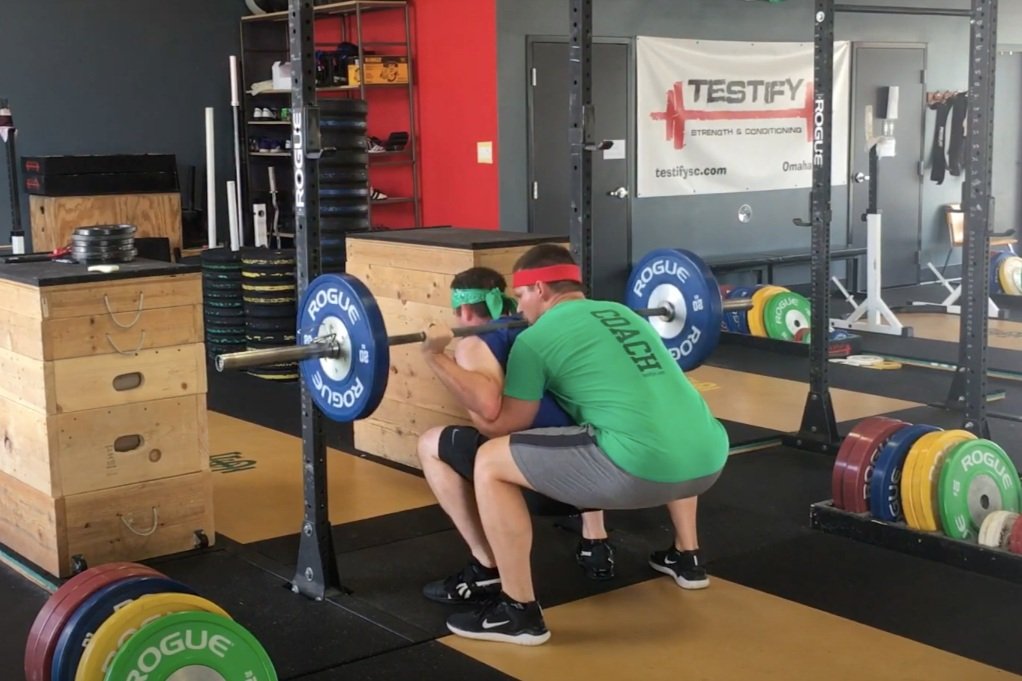The ONE Thing Fitness Magazines WON'T Tell You About the Squat
/There is one thing that fitness magazines will not tell you about squatting . . .
Lean over when you squat.
Why won’t magazines tell you this and why should you lean over? That’s what’s coming up, and we’ll also give you a cue to help you achieve the correct, “leaned-over” position when squatting.
Why Fitness Magazines Won’t Tell You to Lean Over
First, the authors sometimes simply don’t know any better. They don’t know that getting into that nice, efficient, leaned-over position - not totally horizontal, but certainly not vertical - actually puts you in a better, stronger position from which to drive the barbell back up out of the bottom.
Second, magazines and websites are in the business of selling magazines and clicks, respectively, and on the cover of a magazine, leaning over when squatting might look scary to the average Joe or Jane Doe. To the uneducated public, a vertical back angle looks safer than a more horizontal back angle, but this is because the uneducated person is confusing the concept of a vertical back with that of a straight back.
tyler squats 515 lb with a back that is both straight . . . and leaned over.
We want a straight back, of course, but we don’t care too much about a vertical back.
Of course, the back will be vertical at the start and finish of a squat since we start and finish in an upright position, but throughout the squat, the back will take on a range of angles as we work down into that leaned-over position at the bottom of the squat.
The above reasons explain why magazines won’t tell you to lean over, but why do we actually want to lean over?
Why You Should Lean Over When You Squat
Simply put, leaning over puts us in a better, stronger, more efficient position for squatting for a number of reasons, and we’ll get into a few of those today.
Rob achieves a lean-over position - with a straight back - as he squats 445 lb for a set of 5 reps.
First, you’re trying to solve a geometry problem with your body. It’s easier and more efficient to achieve the bottom position of the squat (i.e., hip crease just below the top of the patella) when you get your segments and your joints out of the way. As a result, you’re going to get your knees out of the way by shoving them forward and out (i.e., sideways), you’re going to get your femurs out of the way, you’re going to reach back with your butt (i.e., hips), and because your butt is going to reach back, your back is going to be leaned over.
If you don’t reach back with your hips and lean over with your torso, it will be harder and less efficient to hit depth in your squat, and if you don’t hit depth, the squat doesn’t count.
Second, you’ve got two joints that act as the primary movers in the squat (technically, it’s the muscle mass surrounding these two joints) - the knees and the hips. The farther the knees go forward when you squat, the more load the knees are responsible for (to be precise, the more moment they are handling). On the other end, the farther the hips go backward, the more load the hips are responsible for handling.
You want to use both of these joints in a manner which allows us to use them each to their full potential, and since the hips are the larger joint and surrounded by more muscle mass when compared to the knees, you want to squat in such a way that the hips are asked to do their fair share of the work, so you reach back hard with the hips.
As mentioned earlier, since you reach back with your butt, you have to lean over with your torso. After all, if you only reached back with your hips and didn’t lean over, you’d fall over backward, so leaning over is - in part - a simple counterbalancing mechanism, and you naturally do it every time you sit down into a chair.
In turn, this reaching back of the hips and leaning over of the torso puts you in an excellent position at the bottom of the squat from which to drive your hips straight up out of the hole.
What About Your Back?
You - as an educated lifter - are not concerned about your leaned-over back because you understand the difference between a vertical back and a straight back.
Your back is going to be straight because you always perform your Valsalva maneuver and brace hard before starting each rep (watch the included video if you’re not sure what that means). As a result, your back is a rigid, straight, steel beam capable of handling your work sets just fine.
Isn’t This Stressful on My Back?
Absolutely, and thank goodness it is. Learning how to read and do math applies stress to the brain, and that’s how you become smarter, and training with weights applies stress to your body, and this is how you become stronger. The bones and muscles of your back are part of your body and thus - just like the bones and muscles of your hips and knees - they need stress to get stronger.
This is productive stress - not inappropriate stress. On day one of your training career, you start with a manageable amount of stress - it might be the empty bar for three sets of five reps for some people - your body adapts, and then you apply slightly more stress next time, and the cycle repeats.
Humans have been leaning over to do productive work for thousands of years - don’t let fitness “experts” convince you otherwise.
How Do I Do This Correctly?
To make sure you’re squatting correctly, use the “Squat Trifecta” cue. Watch the included video below for a more in depth explanation as well as demonstration, but in short, when you prepare to start your descent in the squat, use the following three-part cue: “Chest down, butt back, knees out.”
In other words, you’re going to point your chest at the floor (i.e., you’re going to get leaned over), you’re going to reach back with your hips, and you’re going to shove your knees apart. This will help you achieve the correct bottom position in the squat so that you can efficiently and strongly drive up out of the hole.
As always, we hope this helps you get stronger and live better.
(Some links may be affiliate links. As an Amazon Associate, Testify earns from qualifying purchases.)











